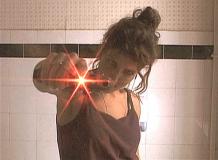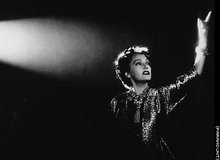




Above are some images from the films, Man With a Movie Camera (Dziga Vertov, 1929), Titicut Follies (Frederick Wiseman, 1969), Harlan County, U.S.A. (Barbara Kopple, 1976) , The Thin Blue Line (Errol Morris, 1988) and the television program Trauma: Life in the ER (TLC 2006).
Documentary film refers in general to all nonfiction film practices, all attempts to visually record, or "document" reality. The conventional assumption is that documentary is "objective," devoid of any subjective bias of the filmmaker and merely a faithful reflection of the "truth" of reality. However, throughout its history, the question of how any form of representation necessarily shapes, rather than simply records, reality has been at the center of all documentary work.
Narrative is selection after all, editing is fundamental to the work of both filmmakers and writers. One of my favorite television programs is the "reality" show Trauma: Life in the ER on the The Learning Channel. A friend of mine works on it: she's a documentary film maker who supports herself as a freelance editor. When I told her how much I liked it, she scoffed, "I hate it! We have to sort through around 5000 hours of film every week and shape it into two or three story lines. By the time I get done its total fiction!"
The fact/fiction barrier is, I hope you are learning, a highly permeable membrane. I think that's one of the points of the short story, "We Kill What We Love," which the fire drill prevented us from talking about in our last discussion session, but which maybe we can remember to talk about in this Tuesday's class. The images above this post are taken from films which illustrate the range of documentary practices throughout film history.
The earliest moving pictures shown to public audiences were by default documentaries. They were single-shot moments captured on film: a train entering a station, a boat docking, an airplane taking off, or mundane scenes of daily life. They were devoted to the sheer novelty of showing moving images of an event. Travelogues, scarcely edited footage of travel to "exotic" locations were probably the next film "form" to emerge: again the emphasis was on the novelty of the technology and the novelty of the experience it could provide an audience.
Shaping film into a narrative, a fictional narrative, followed soon after and early fiction films themselves followed established narrative forms: filmed versions of Great Literature or film scripts which mimicked the narrative structure of plays and novels. That film might have its own narrative language, that as a medium it might offer a different narrative modality are the motivations behind the first real cinematic experimentors, working interestingly enough, on the documentary and nonfiction side of things.
Dziga Vertov, working in the Soviet Union in the 20's and 30's believed the camera, with its varied lenses, shot-counter shot editing, time-lapse, ability to slow motion, stop motion and fast-motion, could render reality more accurately than the human eye and thus produced documentaries that exploit cinematic technique. His films are quite different than the static "aim the camera at the world and walk away" style that is now conventionally associated with documentary film. They transcend the notion that the camera should be limited to merely reproducing the human line of vision (which still dominates all filmmaking, fiction and nonfiction, today) and instead try to capture a "reality" more truthful in its visual representation of multiple images and multiple points of view. For Vertov, the films of people like D. W. Griffith were merely "cliches, copies of copies, films overly indebted to novels and theatrical conventions." Instead, cinema must have " its own rhythm, one lifted from nowhere else, and we find it in the movements of things."
Filmmakers like Frederick Wiseman and Barbara Kopple represent another strand in the tradition: the documentary as visual journalism. Both filmmakers immersed themselves in the culture of the events they filmed. Kopple and her crew spent years with the families of the Kentucky miners whose struggles she filmed in Harlan County U.S.A. In making Titicut Follies, Wiseman spent years fighting powerful institutional and governmental restrictions: not only to get into the Bridgewater State Hospital to film the inmates in the first place, but then to be able to even show his film once it was finished.
These documentaries aim to take viewers as completely as possible into situations outside of the safety of mainstream middle america to reveal the (often government-sanctioned) violence and abuse that is also a part of american society (the shot from Harlan County USA is Kopple and her crew being shot---literally). The visual and narrative style of these documentaries favor the immediacy of the hand held moving camera, following the drama of a situation as it unfolds and historical back story told by utilizing images of newspaper clippings and other archival forms of research.
Errol Morris's The Thin Blue Line is interesting for the way that it combines interviewed testimony with clips of news media coverage and re-enactments of essential plot moments. It explores the true story of the arrest and convinction of Randall Adams for the murder of a Dallas policeman in 1976 and the evidence and argument that it makes eventually led to the overturning of Adam's sentence and his release from prison. In many ways Morris pioneered what has become the dominant look and feel of nonfiction filmmaking, something we see in countless "reality" television programs and recent documentaries like those of Michael Moore and Morgan Spurlock.
I think one way to begin to think about Tarnation is in light of the entire tradition of documentary, one in which the mediated, or consciously crafted status of the image has long been under consideration.
(for some clips from some of the things discussed here, check my Vox blog Extra Things.)
We might also think about autobiography itself as a genre, but my thoughts on that will have to come in a separate post.
































No comments:
Post a Comment